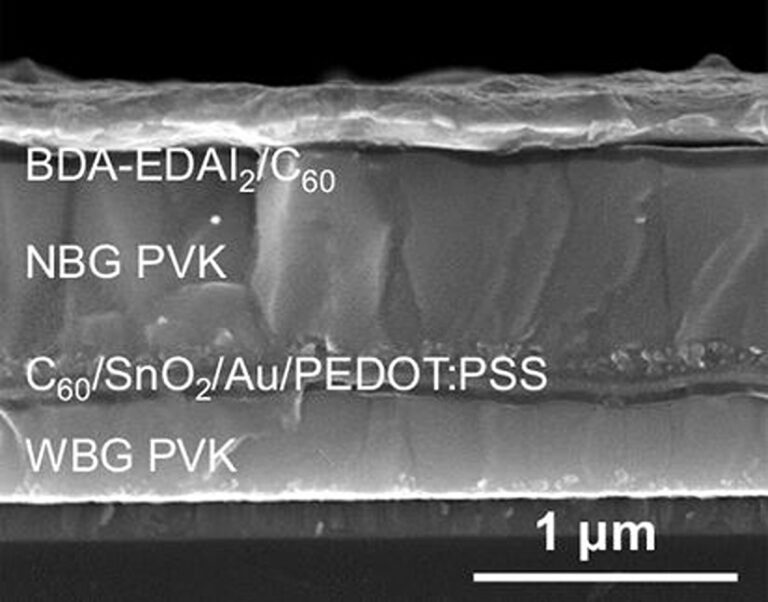Cross-sectional SEM image of all-perovskite TSCs with BDA-EDAI2 modification
Image: Huazhong University of Science and Technology, Nature Communication, Common License CC BY 4.0
A group of researchers from Huazhong University of Science and Technology in China have fabricated an all-perovskite tandem solar cell with a wide bandgap tin-lead (Pb-Sn) perovskite top cell treated with a novel surface reconstruction strategy aimed at reducing solar radiation. Sn defects.
The proposed strategy is reportedly capable of creating high-quality Sn-Pb mixed perovskite films that can help reduce the non-radiative energy losses at the interface of the perovskite-electron transport layer. It consists of the use of 1,4-butanediamine (BDA) and ethylenediammonium diiodide (EDAI2) as surface modifiers, which are reported to yield near-ideal stoichiometric ratio and uniform surface potential, as well as well-aligned Femi levels.
The group built a 0.0871 cm2 cell with the treated Sn-Pb perovskite absorber, an electron transport layer (ETL) based on buckminsterfullerene (C60), a hole transport layer (HTL) based on PEDOT-PSS, and a gold (Au) metal contact.
The best performing BDA-EDAI2 The modified device achieved a power conversion efficiency of 28.80%, an open-circuit voltage of 2.13 V (2.13 V), a short-circuit current density of 16.06 mA cm−2and a fill factor of 84.19%. “We also verified the effectiveness of the surface reconstruction in module-level devices and obtained a champion PCE of 23.39% with an opening area of 11.3 cm2,” said the academics.
Furthermore, they found that the encapsulated tandem cells retained 79.7% of their initial efficiency after continuous operation under Maximum Power Point Tracking (MPPT) in ambient air for 550 hours.
An unspecified third-party organization also stated that the best-performing devices achieved an efficiency of 28.49%, which the research group described as one of the highest efficiencies ever reported for all-perovskite solar cells.
“It is impressive that our Sn-Pb PSCs mixed with BDA-EDAI2 The modification showed PCEs of 22.65% and 23.32% for 1.32 and 1.25 eV band gap, respectively, and with significantly higher open-circuit voltage and fill factor,” the academics concluded.
The new cell concept was introduced in the study “Chemical polishing and surface passivation minimize non-radiative recombination for all-perovskite tandem solar cells”, published in communication about nature.
This content is copyrighted and may not be reused. If you would like to collaborate with us and reuse some of our content, please contact: editors@pv-magazine.com.
Popular content



